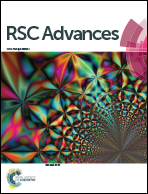Multifunctional electropolymerizable carbazole-based ionic liquids†
Abstract
Electropolymerizable carbazole-functionalized imidazolium and pyridinium-based ionic liquids (ILs) were synthesized and characterized using 1H, 13C, 19F NMR, and ESI-MS. They were electropolymerized onto indium tinoxide (ITO) electrodes via cyclic voltammetric polymerization in several selected room temperature ILs (RTILs) as well as in conventional organic solvents. Two redox couples, corresponding to the monomer and polymer, respectively, of the carbazole-functionalized ILs, were observed during the cyclic voltammetric polymerization. It was found, as common ILs, that the anionic components exhibit crucial effects on the physicochemical properties of the carbazole-functionalized ILs. The anions of which were replaced by the anions of the electrolytes in which the monomers were dissolved. The RTILs used for the electropolymerization thus determined the electrochemical behavior of the monomers, the surface morphologies and the physicochemical properties of the poly(ILs) films. After the modification of ITO electrodes with poly(ILs), the electrochemical performance of the semiconducting electrodes was significantly improved towards uric acid oxidation. The poly(ILs) show adjustable properties (via counter anions), and exhibit a wide range of solubility in organic solvents, and electrochromic and solvatochromic properties.


 Please wait while we load your content...
Please wait while we load your content...